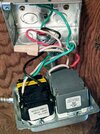davewill
Active Member
In general, people DON'T have problems with them. Every now and then, someone comes here complaining that their GFCI is tripping, and we usually just recommend they replace them and that fixes the problem.This is a very hard thread to follow, partly because the OP insists on using goofy language for the parts he is using, such as 'Magic Plastic'.
I came here looking for info on what is going on with using GFCI on the outlet the mobile connector is plugged into. My understanding is this is part off the NEMA code, so is required, and no way around that. I'm not putting anything in my home that isn't up to snuff.
I can't understand why a pair of cascaded GFCI devices would have any impact on each other. The GFCI is just a toroid transformer core, with both sides of the power line wound through it. The polarity of the windings is such that the two will cancel as long as they are equal. When unequal, a net flux causes current to flow in a sense wire wound on the same core, which can be sensed and used to trip a relay. There is no reason to think having a second GFCI downstream of the first, would cause any problem with operation of either. Yet, I see this reported repeatedly.
I don't see where anyone in this thread explains why this would be a problem. More importantly, I don't see where anyone has a solution.
To the best of my knowledge, all EVSE contain a GFCI, in fact, I believe it is required in the spec. NEMA requires a GFCI in the outlet in locations like the garage. I don't see how EVSE makers can be selling these devices without having problems with them. The only solution would seem to be to not use an outlet, rather direct wire the EVSE.
The EVSE does a very brief ground test when it powers up, where it passes a miniscule amount of current throught the ground to verify it's connected. It's designed to do this without tripping a GFCI, but if one is very sensitive, it can. Once again, replacement with something newer generally does the trick.



